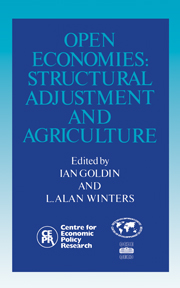Book contents
- Frontmatter
- Contents
- List of figures
- List of tables
- Preface
- Acknowledgements
- List of conference participants
- 1 Introduction: from macro to maize
- Part One Open economy analysis
- 2 Sequencing and welfare: labour markets and agriculture
- Discussion
- 3 Agricultural adjustment and the Mexico-USA free trade agreement
- Discussion
- 4 Do the benefits of fixed exchange rates outweigh their costs? The CFA Zone in Africa
- Discussion
- 5 Adjustment and the rural sector: a counterfactual analysis of Morocco
- Discussion
- Part Two The small country assumption and trade reform
- Part Three Risk and adjustment
- Part Four Government's role
- Index
Discussion
from Part One - Open economy analysis
Published online by Cambridge University Press: 04 August 2010
- Frontmatter
- Contents
- List of figures
- List of tables
- Preface
- Acknowledgements
- List of conference participants
- 1 Introduction: from macro to maize
- Part One Open economy analysis
- 2 Sequencing and welfare: labour markets and agriculture
- Discussion
- 3 Agricultural adjustment and the Mexico-USA free trade agreement
- Discussion
- 4 Do the benefits of fixed exchange rates outweigh their costs? The CFA Zone in Africa
- Discussion
- 5 Adjustment and the rural sector: a counterfactual analysis of Morocco
- Discussion
- Part Two The small country assumption and trade reform
- Part Three Risk and adjustment
- Part Four Government's role
- Index
Summary
As with a good jazz musician, we have got used to hearing from Sebastian Edwards many variations on a theme. The theme is the sequencing of structural reform. The variation this time in Chapter 2, is a two-period model to explore two previously neglected aspects of the sequencing literature: the role of labour market distortions and the impact of reform on agriculture. Edwards arrives at a very agnostic result (which is also contrary to some of his earlier findings): from a rigorous welfare perspective it does not matter whether you first liberalise trade, dismantle capital controls, or deregulate labour markets. Either this is a very important result which joins those who have stressed political economy considerations, or it merely reflects the failure of Edwards's model to capture some aspects relevant to the sequencing problem. Let me try to explore this second explanation.
Less agnosticism may be produced by modifying Edwards's model in three ways: (1) by giving a more realistic description of the labour market in LDCs, (2) by introducing a richer production function, and (3) by redefining sectors.
First, the labour market. In Edwards's model, for example, financial opening will reduce employment in agriculture. Financial opening in period 1 raises the real exchange rate, here defined as the price of services relative to tradables. Appreciation raises the demand for labour in the service sector and, due to the labour market constraint, reduces employment in agriculture. What do we observe, by contrast, in reality? Search unemployment in the urban informal service sector, disguised lowproductivity unemployment in the rural sector, and a tendency of industry to contract as a result of real appreciation.
- Type
- Chapter
- Information
- Open EconomiesStructural Adjustment and Agriculture, pp. 39 - 41Publisher: Cambridge University PressPrint publication year: 1992



